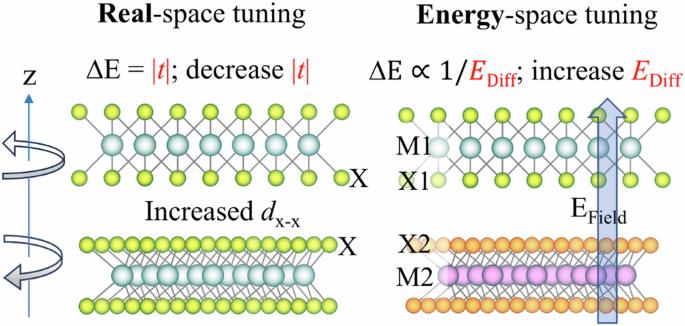通过实空间和能量空间调整实现典型二维过渡金属二钙化结的直接带隙
IF 7.5
Q1 MATERIALS SCIENCE, MULTIDISCIPLINARY
引用次数: 0
摘要
VIB 族二维(2D)过渡金属二卤化物(TMDs;MoS2、WS2、MoSe2 和 WSe2)的大多数范德华同结和异结显示出间接能带隙,这阻碍了它们的一些应用,尤其是在光电子领域。在当前的研究中,我们基于对层间电子杂化的定量分析,证明了大多数由 VIB 族 TMDs 组成的双层甚至少数层可以通过实际和/或能量空间调整有效削弱层间相互作用,从而获得直接能带隙。这里的实空间调整是指在层间引入大角度旋转错位,这已在最近的一次实验中实现;能量空间调整是指在层间引入能量失配,由于二维半导体 TMD 的垂直介电常数较小,因此可以通过不同的方法有效地引入能量失配。本文提出的实空间和能空间的高效调谐为 TMD 和其他二维半导体的同质结和异质结的间接-直接间隙调节铺平了道路。值得注意的是,这两种调节都可以永久保留,因此我们的工作对二维半导体的各种应用具有重要意义。VIB 族二维过渡金属二卤化物的大多数范德华同结和异结都具有间接带隙。在这里,作者展示了一种通过旋转错位或层间能量失配来调整层间相互作用,从而在这些系统中诱导直接带隙的方法。本文章由计算机程序翻译,如有差异,请以英文原文为准。

Toward direct band gaps in typical 2D transition-metal dichalcogenides junctions via real and energy spaces tuning
Most of the van der Waals homo- and hetero-junctions of group VIB two-dimensional (2D) transition-metal dichalcogenides (TMDs; MoS2, WS2, MoSe2, and WSe2) show indirect energy band gaps which hinders some of their applications especially in optoelectronics. In the current work, we demonstrate that most of the bilayers and even few-layers consisting of group VIB TMDs can have direct gaps by efficient weakening of their interlayer interactions via real and/or energy spaces tuning, which is based on insights from quantitative analyses of interlayer electronic hybridizations. Real space tuning here means introducing large-angle rotational misalignment between layers, which has been realized in a very recent experiment; and, energy space tuning means introducing energy mismatch between layers which can be introduced efficiently by different means thanks to the small vertical dielectric constant of 2D semiconducting TMDs. The efficient tuning in both real and energy spaces proposed here paves an avenue for indirect-direct gap regulation of homo- and hetero-junctions of TMDs and other 2D semiconductors. Notably, both tuning can be permanently preserved and hence our work is of great significance for the diverse applications of 2D semiconductors. Most van der Waals homo- and hetero-junctions of 2D transition-metal dichalcogenides of group VIB have indirect bandgaps. Here, the authors demonstrate a way of inducing direct gaps in these systems by tuning interlayer interactions via rotational misalignment or energy mismatch between layers.
求助全文
通过发布文献求助,成功后即可免费获取论文全文。
去求助
来源期刊

Communications Materials
MATERIALS SCIENCE, MULTIDISCIPLINARY-
CiteScore
12.10
自引率
1.30%
发文量
85
审稿时长
17 weeks
期刊介绍:
Communications Materials, a selective open access journal within Nature Portfolio, is dedicated to publishing top-tier research, reviews, and commentary across all facets of materials science. The journal showcases significant advancements in specialized research areas, encompassing both fundamental and applied studies. Serving as an open access option for materials sciences, Communications Materials applies less stringent criteria for impact and significance compared to Nature-branded journals, including Nature Communications.
 求助内容:
求助内容: 应助结果提醒方式:
应助结果提醒方式:


